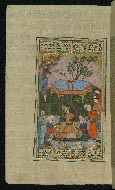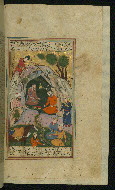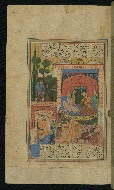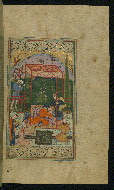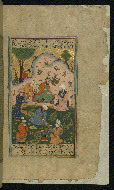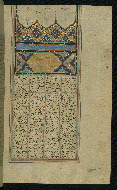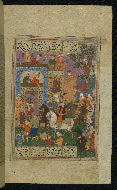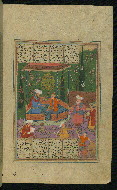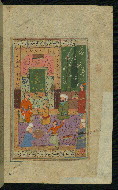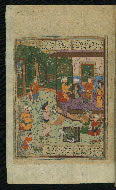Home > Digitized Walters Manuscripts
This document is a tranformation of a TEI P5 XML manuscript description incorporating images. If you have trouble reading special or non-Latin characters on this page, please make sure you have appropriate Unicode fonts installed and an up-to-date web browser.
Walters Ms. W.623, Collection of poetry
Browse images (Browse images in a new window) | TEI in XML format
W.623
Collection of poetry
Vernacular: خمسه دهلوى
Qirān-i saʿdaynVernacular: قران سعدين
Nuh sipihrVernacular: نه سپهر
Authority name: Amīr Khusraw Dihlavī, ca. 1253-1325
As-written name: Amīr Khusraw Dihlavī
Name, in vernacular: امير خسرو دهلوى
Note: Author dates preferred by cataloger: d. 725 AH / 1325 CE
This illuminated and illustrated manuscript contains the Khamsah (quintet) and two historical poems (masnavi), Qirān-i saʿdayn and Nuh sipihr, by Amīr Khusraw Dihlavī (d. 725 AH / 1325 CE). The codex is dated 1017 AH / 1609 CE and was produced in Safavid Iran. All texts are written in black nastaʿlīq script with chapter headings in red. The manuscript opens with an illuminated and illustrated frontispiece of a hunting and court scene in the early Safavid style (fols. 1b-2a). The first text is Khamsah-i Dihlavī (fols. 2b-192a), which is introduced by an illuminated incipit and titlepiece with the title of the first poem of the quintet and the author's name. The second text is Qirān-i saʿdayn, a historical poem (masnavi) about the meeting of Sultan Muʿizz al-Dīn Kayqubād and his father, Nāṣir al-Din Bughrā Khān, on the banks of the Sarjū in Oudh. It is also introduced with an illuminated incipit and titlepiece (fol. 193b). The third text is Nuh sipihr, a historical poem (masnavi) describing the glories of Sultan Quṭb al-Dīn Mubārak Shāh Khaljī’s time, introduced with an illuminated incipit and headpiece (fol. 223b). The dark brown leather binding is original to the manuscript.
30 Ramaḍān -- 22 Dhū al-Ḥijjah 1017 AH / 1609 CE
Iran
Book
Literary -- Poetry
Historical
The primary language in this manuscript is Persian.
- Transliteration: Fol. 64a: tammat al-kitāb Laylá Majnūn-i Amīr Khusraw Dihlavī dar /1/ tārīkh-i salkh-i Ramaz̤ān al-mubārak sanat-i sabʿ ʿashar va alf /2/; Fol. 111b: tammat al-kitāb bi-ʿawn al-Malik al-Wahhāb tamām shud kitāb /1/ Iskandar nāmah-i Amīr Khusraw Dihlavī dar tārīkh-i s̱ānī va ʿishrīn /2/ shahr Dhū al-Ḥijjah sanat-i sabʿ ʿashar va alf /3/
- Comment: Two colophons on 64a and 111b give the dates of copying and the titles of the individual poems: Majnūn va Laylá and Āyinah-i Iskanadarī
Paper
Mostly laid paper; some leaves European with watermarks
Foliation: i+272
Each poem of the Khamsah foliated separately using Hindu-Arabic numerals
Catchwords: Written obliquely on versos
Comments:
22.0 cm wide by 34.5 cm high
fols. 1b - 192a: 12.0 cm wide by 22.5 cm high
fols. 193b - 223a: 12.0 cm wide by 22.5 cm high
fols. 223b - 269a: 12.0 cm wide by 22.5 cm high
- Columns: 4
- Ruled lines: 25
- Framing lines in gold, blue, red, brown, green, and white
- Columns: 4
- Ruled lines: 25
- Columns: 4
- Ruled lines: 25
- Title: Khamsah-i Dihlavī
- Author: Amīr Khusraw Dihlavī, ca. 1253-1325
- Incipit: بسم الله الرحمن الرحيم خطبه قدس است بملك قديم...
- Text note: Contains the following poems: Matlaʿ al-anvār (fols. 2b-39a), Majnūn va Laylá (fols. 40b-64a), Āyinah-i Iskanadarī (fols. 64b-111a), Hasht bihisht (fols. 111b-147a), and Shīrīn va Khusraw (fols. 147b-192a)
- Hand note: Written in black nastaʿlīq script with chapter headings in red
- Decoration note: Seventeen illustrations; illuminated and illustrated frontispiece inscribed with the title and the author's name (fols. 1b-2a); illuminated incipits with titlepieces and cloud-bands between the lines, some with decorated borders; frame
- Title: Qirān-i saʿdayn
- Author: Amīr Khusraw Dihlavī, ca. 1253-1325
- Incipit: حمد خداوند سرايم نخست...
- Hand note: Written in black nastaʿlīq script with chapter headings in red
- Decoration note: One illustration; illuminated incipit with titlepiece and cloud-bands; frame
- Title: Nuh sipihr
- Author: Amīr Khusraw Dihlavī, ca. 1253-1325
- Incipit: خدارا كنم بر سر نامه يد...
- Text note: Incomplete at end
- Hand note: Written in black nastaʿlīq script; chapter headings not filled in
- Decoration note: Five illustrations; illuminated incipit with headpiece and cloud-bands; frame
fol. 1b:
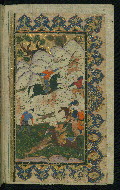
- Title: Hunting scene
- Form: Illustration; frontispiece
- Label: This is the right side of a double-page illuminated and illustrated frontispiece of the Khamsah-i Dihlavī.
fol. 2a:
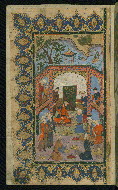
- Title: Court scene
- Form: Illustration; frontispiece
- Label: This is the left side of a double-page illuminated and illustrated frontispiece of the Khamsah-i Dihlavī.
fol. 2b:
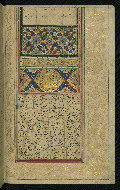
- Title: Incipit page with illuminated titlepiece
- Form: Incipit; titlepiece
- Text: Maṭlaʿ al-anvār
- Label: This incipit page has an illuminated titlepiece inscribed: Kitāb Maṭlaʿ al-anvār min Khamsat Amīr Khusraw ʿalayhi al-raḥmah. There is interlinear decoration of gilt and polychrome floral motifs and an outer illuminated border.
fol. 26a:
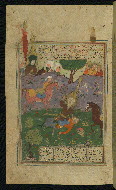
- Title: 'Ali’s initial reaction to an infidel who has spat in his face
- Form: Illustration
- Text: Maṭlaʿ al-anvār
fol. 28a:
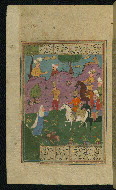
- Title: A king out hunting accidentally kills a youth
- Form: Illustration
- Text: Maṭlaʿ al-anvār
- Label: A king out hunting, having accidentally killed a youth, offers the boy's mother his life or a platter of gold.
fol. 40b:
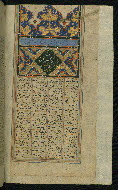
- Title: Incipit page with illuminated titlepiece
- Form: Incipit; titlepiece
- Text: Majnūn va Laylá
- Label: This incipit page has an illuminated titlepiece inscribed: Kitāb-i Laylá va Majnūn-i Amīr Khusraw Dihlavī.
fol. 49a:
fol. 64b:
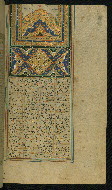
- Title: Incipit page with illuminated titlepiece
- Form: Incipit; titlepiece
- Text: Āyinah-i Iskanadarī
- Label: This incipit page has an illuminated titlepiece inscribed: Kitāb-i Āyinah-i Iskanadarī-i Amīr Khusraw Dihlavī raḥmat Allāh ʿalayhi.
fol. 72a:
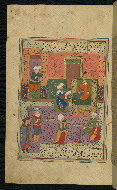
- Title: The Khāqān of China receives a letter from Alexander the Great
- Form: Illustration
- Text: Āyinah-i Iskanadarī
- Label: The Khāqān of China receives a letter from Alexander the Great (Iskandar) demanding his surrender.
fol. 81b:
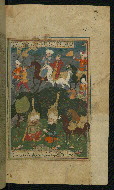
- Title: Alexander the Great searches for the Fountain of Life
- Form: Illustration
- Text: Āyinah-i Iskanadarī
- Label: Alexander the Great (Iskandar) searches for the Fountain of Life which is made invisible by the prophets Khiz̤r and Ilyās.
fol. 89b:
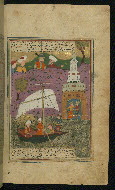
- Title: Alexander the Great invents a mirror
- Form: Illustration
- Text: Āyinah-i Iskanadarī
- Label: Alexander the Great (Iskandar) invents a mirror that, when mounted on a tower, shows everything within a radius of 60 farsangs and thus enables Alexander’s men to attack marauding pirates.
fol. 95b:
fol. 108b:
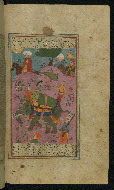
- Title: Alexander the Great's army carries his casket back to Greece
- Form: Illustration
- Text: Āyinah-i Iskanadarī
fol. 111b:
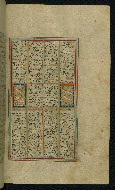
- Title: Text page
- Form: Text page
- Text: Āyinah-i Iskanadarī
- Label: This text page marks the end of Āyinah-i Iskanadarī and the beginning of Hasht bihisht. The latter is introduced by two panels with the inscription: Bāb fatḥ Hasht bihist.
fol. 118b:
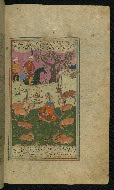
- Title: Bahrām Gūr recognizes Dilārām
- Form: Illustration
- Text: Hasht bihist
- Label: Bahrām Gūr recognizes Dilārām by the music with which she enchants the animals.
fol. 129b:
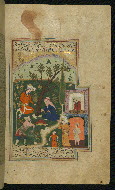
- Title: Bahrām Gūr in the red pavilion
- Form: Illustration
- Text: Hasht bihist
- Label: This is the story of the princess in the red pavilion. A prince befriends an old woman in order to gain access to the tower and abduct his beloved.
fol. 139a:
fol. 147b:
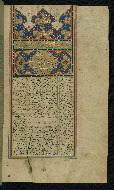
- Title: Incipit page with illuminated titlepiece
- Form: Incipit; titlepiece
- Text: Khusraw va Shīrīn
- Label: This incipit page has an illuminated titlepiece inscribed: Kitāb-i Khusraw Shīrīn-i Amīr Khusraw Dihlavī raḥmat Allāh ʿalayhi.
fol. 160b:
fol. 169b:
fol. 179b:
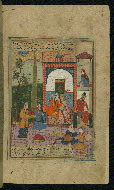
- Title: Khusraw and Shīrīn are entertained at their wedding
- Form: Illustration
- Text: Khusraw va Shīrīn
fol. 188b:
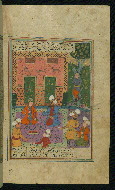
- Title: Buzurg Umīd tells Khusraw the story of a king’s punishment of a rude messenger
- Form: Illustration
- Text: Khusraw va Shīrīn
fol. 193b:
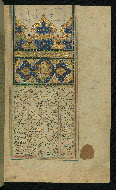
- Title: Incipit page with illuminated titlepiece
- Form: Incipit; titlepiece
- Text: Qirān-i saʿdayn
- Label: This incipit page has an illuminated titlepiece inscribed: Kitāb-i Qirān-i saʿdayn-i Amīr Khusraw.
fol. 212b:
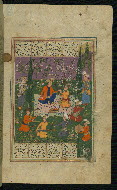
- Title: Sultan Muʿizz al-Dīn is reconciled with his father, Naṣīr al-Dīn Bughrā Khān
- Form: Illustration
- Text: Qirān-i saʿdayn
fol. 223b:
fol. 237b:
fol. 250b:
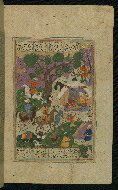
- Title: Scenes from the wintry period in India (December and January)
- Form: Illustration
- Text: Nuh sipihr
fol. 259b:
fol. 263b:
fol. 268a:
The binding is original.
Dark brown leather (without flap); dentelle style with central ovals, pendants, cornerpieces, and frames decorated and brushed with gold
Ownership statement: Ibn Abī Ḥusayn ʿAlī [...] ʿAlī, plus seal (fol. 1a)
Walters Art Museum, 1931, by Henry Walters bequest
Rieu, Charles. Catalogue of the Persian Manuscripts in the British Museum, Vol. 2. (London: British Museum, 1879-83), 611-612.
Seyller, John. Pearls of the Parrot of India: The Walters Art Museum Khamsa of Amīr Khusraw of Delhi. (Baltimore: Walters Art Museum, 2001), 155.
Principal cataloger: Gacek, Adam
Catalogers: Landau, Amy; Smith, Sita
Copy editor: Bockrath, Diane
Conservators: Jewell, Stephanie; Quandt, Abigail
Contributors: Barrera, Christina; Emery, Doug; Herbert, Lynley; Noel, William; Simpson, Shreve; Tabritha, Ariel; Toth, Michael B.; Valle, Chiara
The Walters Art Museum
Licensed for use under Creative Commons Attribution-NonCommercial-ShareAlike 3.0 Unported Access Rights, http://creativecommons.org/licenses/by-nc-sa/3.0/legalcode. It is requested that copies of any published articles based on the information in this data set be sent to the curator of manuscripts, The Walters Art Museum, 600 North Charles Street, Baltimore MD 21201.
